FROM TAMIL LITERATURE:
Mythical beasts appear as a hybrid or chimera of two or more animals, depicted in ancient literature as symbols of power and domination. some paleontologists claim they might well be transliterated representations of some extinct prehistoric animals of last ice age.
1. AALI / YAALI - யாளி / ஆளி :
The archaic Tamil word "Aali" literally means "wrath of mother nature"; has the head of a lion with the tusks of an elephant, the body of a lion and the tails of serpents. Legends of the might of "Aali" in Sangam literature include an Aali devouring upon a dragon-python beast, which was about to swallow the huge royal elephant, which was about to trample down an enemy general mounted upon a war-horse. They are said to be more powerful than the elephant and the lion. They appear upon the pillars of Hindu temples and sometimes in art are seen on the backs of the Makara. From the ancient Tamil name "Yali" comes the Sanskrit ‘Vyala’ -literally meaning "derived from Aali". The North Indian Yali can have many variations -with heads of lions, horses, dogs, and humans.






2. SARABAM - சரபம் :
A killer of lions, a giant bird with huge wings, and two heads, trunks and eight legs of twin lions.
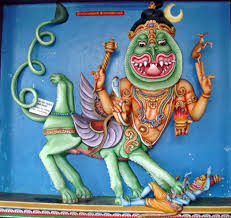


3. POGUVAL : பொகுவல் : பேரெழாஅல்-பெருங்கூகை :
A giant bird with face and trunk of owl (Perunkoogai), wings of great eagle (Per-ezhaa'al), elephant snout, whale teeth in upper jaw, giant chameleon tongue,
Other beasts of Hindu mythology:
4. Magara :




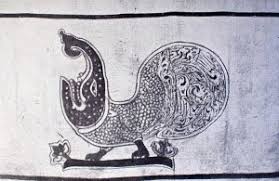
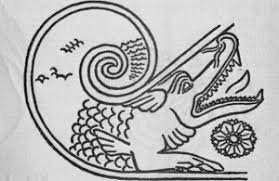

மகரம் :
A very late derivative of the ancient Tamil mystical chimera "Poguval" is the 'Makara' meaning "sea dragon" or "water-monster" with the hybrid creature formed from a number of animals such that collectively possess the nature of a crocodile. It has the lower jaw of a crocodile, the snout or trunk of an elephant, the tusks and ears of a wild boar, the darting eyes of a monkey, the scales and the flexible body of a fish, and the swirling tailing feathers of a peacock."[7].
In the mythologies of South-east Asia, China and Japan, the depiction is in the form of half fish or seal with head of an elephant. It is also shown in an anthropomorphic (abstract form) with head and jaws of a crocodile, an elephant trunk with scales of fish and a peacock tail.
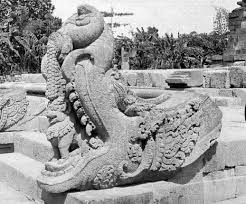
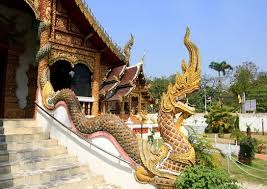

5. Tibetan "Chu-srin":[1]
A hybrid creature[2] with a "elephant trunk (snout), fish body, lions fore paws, a horse's mane, the gills and tendrils of a fish, and the horns of a deer or dragon. From its once simple fishtail, sometimes feathered, now emerges as a complex spiraling floral pattern known as makara-tail design".[7]




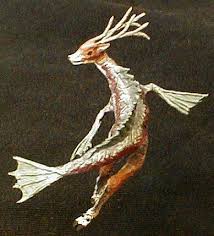
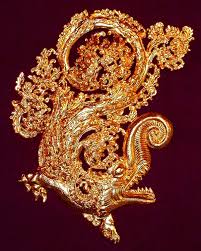
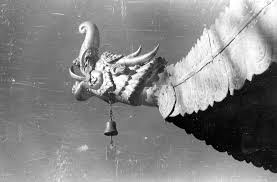
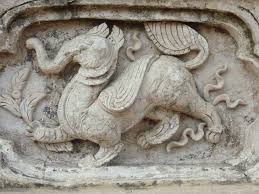
In Tibetan iconography, it is depicted in the Vajrayana as a weapon of strength and tenacity. The Vajrayan weapons which have makara symbolism are; axe, iron hook, curved knife, vajra, and ritual dragon, in all of which the theme is "emergence of the blade from the open mouth of the makara".[7]
Mythical beasts appear as a hybrid or chimera of two or more animals, depicted in ancient literature as symbols of power and domination. some paleontologists claim they might well be transliterated representations of some extinct prehistoric animals of last ice age.
1. AALI / YAALI - யாளி / ஆளி :
The archaic Tamil word "Aali" literally means "wrath of mother nature"; has the head of a lion with the tusks of an elephant, the body of a lion and the tails of serpents. Legends of the might of "Aali" in Sangam literature include an Aali devouring upon a dragon-python beast, which was about to swallow the huge royal elephant, which was about to trample down an enemy general mounted upon a war-horse. They are said to be more powerful than the elephant and the lion. They appear upon the pillars of Hindu temples and sometimes in art are seen on the backs of the Makara. From the ancient Tamil name "Yali" comes the Sanskrit ‘Vyala’ -literally meaning "derived from Aali". The North Indian Yali can have many variations -with heads of lions, horses, dogs, and humans.

2. SARABAM - சரபம் :
A killer of lions, a giant bird with huge wings, and two heads, trunks and eight legs of twin lions.

3. POGUVAL : பொகுவல் : பேரெழாஅல்-பெருங்கூகை :
A giant bird with face and trunk of owl (Perunkoogai), wings of great eagle (Per-ezhaa'al), elephant snout, whale teeth in upper jaw, giant chameleon tongue,
Other beasts of Hindu mythology:
4. Magara :

மகரம் :
A very late derivative of the ancient Tamil mystical chimera "Poguval" is the 'Makara' meaning "sea dragon" or "water-monster" with the hybrid creature formed from a number of animals such that collectively possess the nature of a crocodile. It has the lower jaw of a crocodile, the snout or trunk of an elephant, the tusks and ears of a wild boar, the darting eyes of a monkey, the scales and the flexible body of a fish, and the swirling tailing feathers of a peacock."[7].
In the mythologies of South-east Asia, China and Japan, the depiction is in the form of half fish or seal with head of an elephant. It is also shown in an anthropomorphic (abstract form) with head and jaws of a crocodile, an elephant trunk with scales of fish and a peacock tail.
5. Tibetan "Chu-srin":[1]
A hybrid creature[2] with a "elephant trunk (snout), fish body, lions fore paws, a horse's mane, the gills and tendrils of a fish, and the horns of a deer or dragon. From its once simple fishtail, sometimes feathered, now emerges as a complex spiraling floral pattern known as makara-tail design".[7]
In Tibetan iconography, it is depicted in the Vajrayana as a weapon of strength and tenacity. The Vajrayan weapons which have makara symbolism are; axe, iron hook, curved knife, vajra, and ritual dragon, in all of which the theme is "emergence of the blade from the open mouth of the makara".[7]


